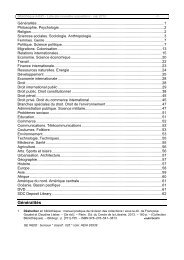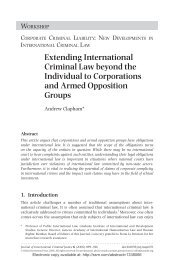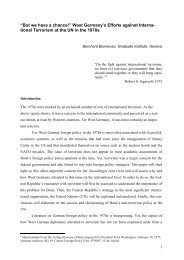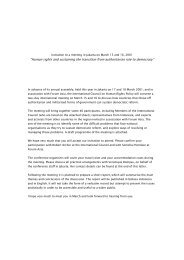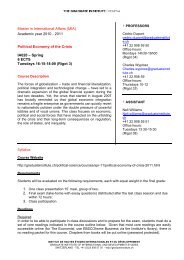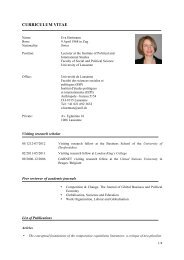The 1953 Coup D'etat in Iran Author(s): Mark J. Gasiorowski Source ...
The 1953 Coup D'etat in Iran Author(s): Mark J. Gasiorowski Source ...
The 1953 Coup D'etat in Iran Author(s): Mark J. Gasiorowski Source ...
Create successful ePaper yourself
Turn your PDF publications into a flip-book with our unique Google optimized e-Paper software.
262 <strong>Mark</strong> J. <strong>Gasiorowski</strong><br />
<strong>Iran</strong>'s new prime m<strong>in</strong>ister. Mosaddeq was a lawyer and wealthy landowner who<br />
had been a prom<strong>in</strong>ent political figure <strong>in</strong> <strong>Iran</strong> s<strong>in</strong>ce the early 1900s. In his long<br />
years <strong>in</strong> public service, Mosaddeq had ga<strong>in</strong>ed a reputation as a liberal democrat<br />
and an ardent nationalist. By the late 1940s, he had identified himself with two<br />
ma<strong>in</strong> issues: a desire to transfer political power from the royal court to the<br />
parliament (known as the Majlis), and a desire to <strong>in</strong>crease <strong>Iran</strong>'s control over its<br />
oil <strong>in</strong>dustry, which was controlled by the British-owned Anglo-<strong>Iran</strong>ian Oil<br />
Company (AIOC). In the late 1940s, these two issues were becom<strong>in</strong>g <strong>in</strong>creas<strong>in</strong>gly<br />
prom<strong>in</strong>ent <strong>in</strong> <strong>Iran</strong>ian politics. Moreover, they had become closely <strong>in</strong>terrelated by<br />
this time: the British had become extremely powerful <strong>in</strong> <strong>Iran</strong>, due ma<strong>in</strong>ly to their<br />
control over the oil <strong>in</strong>dustry, and they used their power <strong>in</strong> part to help the Shah;<br />
the Shah, for his part, was widely viewed as a British puppet and had refused to<br />
renegotiate or nationalize the AIOC concession.4<br />
<strong>The</strong>se two issues came to eclipse all others <strong>in</strong> 1949, when a new oil agreement<br />
favorable to the AIOC was announced and when the Shah then tried to rig the<br />
16th Majlis elections. <strong>The</strong>se actions enraged the opposition. Large demonstra-<br />
tions ensued and an organization known as the National Front was formed to<br />
coord<strong>in</strong>ate opposition to the Shah and to the British. Mosaddeq soon emerged<br />
as its defacto leader.<br />
<strong>The</strong> National Front was a broad coalition of groups and political parties based<br />
ma<strong>in</strong>ly on the urban middle and lower classes. Its ma<strong>in</strong> components were the<br />
progressive, nationalist <strong>Iran</strong> party, led by Karim Sanjabi and Allahyar Saleh and<br />
composed ma<strong>in</strong>ly of leftist, anti-Soviet <strong>in</strong>tellectuals; the Toilers' party, led by<br />
Mozaffar Baqai and Khalel Maleki and composed of both workers and leftist<br />
<strong>in</strong>tellectuals; and the Mojahid<strong>in</strong>-i-lslam, led by Ayatollah Abul Qassem Kashani<br />
and composed ma<strong>in</strong>ly of workers, bazaar merchants, and rank-and-file clergy.<br />
Associated with the National Front (but not formally affiliated with it) was the<br />
Pan-<strong>Iran</strong>ist party, a shadowy, ultra-nationalist group composed ma<strong>in</strong>ly of lower<br />
class toughs. <strong>The</strong> National Front also attracted a large number of unaffiliated<br />
<strong>in</strong>dividuals, particularly among the middle class. <strong>The</strong> ma<strong>in</strong> opposition organiza-<br />
tions not affiliated with the National Front were the communist Tudeh party and<br />
the Feday<strong>in</strong>-i-Islam.5<br />
In 1950, the National Front led frequent demonstrations aga<strong>in</strong>st the Shah and<br />
the British. It also managed to elect eight candidates to the 16th Majlis, <strong>in</strong>clud<strong>in</strong>g<br />
Mosaddeq. Once <strong>in</strong> the Majlis, the National Front deputies cont<strong>in</strong>ued to press<br />
for a reduction of the Shah's powers and, after June 1950, for nationalization of<br />
the oil <strong>in</strong>dustry. In March 1951, Mosaddeq submitted a bill call<strong>in</strong>g for nationali-<br />
zation of the oil <strong>in</strong>dustry to the Majlis. This bill was quickly passed, and<br />
Mosaddeq was soon appo<strong>in</strong>ted prime m<strong>in</strong>ister. On May 1, immediately after<br />
tak<strong>in</strong>g office, Mosaddeq signed the nationalization bill <strong>in</strong>to law.6<br />
<strong>The</strong> nationalization law quickly brought Mosaddeq <strong>in</strong>to direct conflict with<br />
the British government, which owned 50% of the AIOC's stock and was not<br />
prepared to accept outright nationalization. In the ensu<strong>in</strong>g months, the British<br />
adopted a three-track strategy designed to reestablish their control over <strong>Iran</strong>'s oil<br />
by either pressur<strong>in</strong>g Mosaddeq <strong>in</strong>to a favorable settlement or by remov<strong>in</strong>g him<br />
from office.7



![Download [pdf] - The Graduate Institute, Geneva](https://img.yumpu.com/23370020/1/190x248/download-pdf-the-graduate-institute-geneva.jpg?quality=85)
